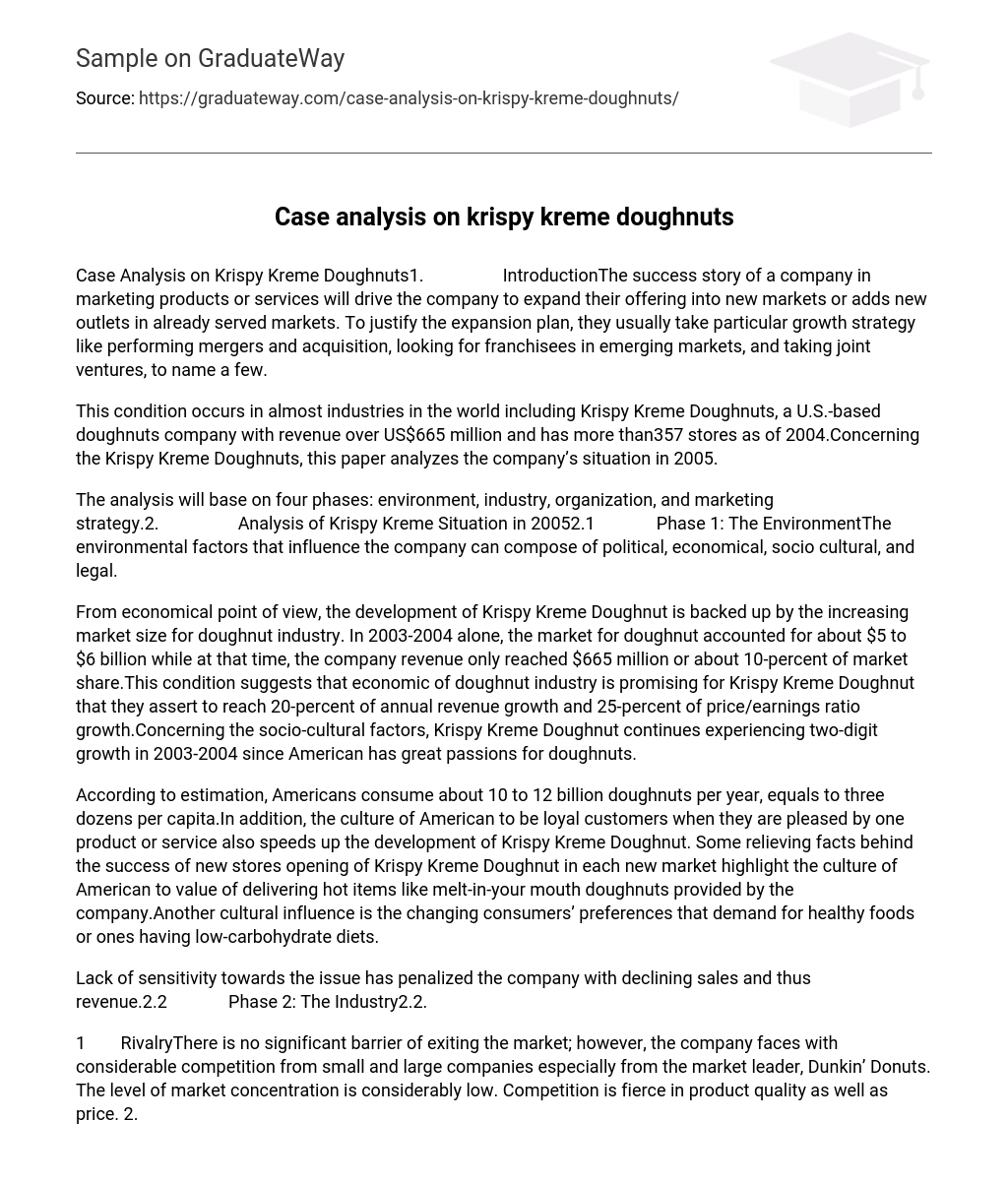Introduction
The success story of a company in marketing products or services will drive the company to expand their offering into new markets or adds new outlets in already served markets. To justify the expansion plan, they usually take particular growth strategy like performing mergers and acquisition, looking for franchisees in emerging markets, and taking joint ventures, to name a few.
This condition occurs in almost industries in the world including Krispy Kreme Doughnuts, a U.S.-based doughnuts company with revenue over US$665 million and has more than357 stores as of 2004.Concerning the Krispy Kreme Doughnuts, this paper analyzes the company’s situation in 2005.
The analysis will base on four phases: environment, industry, organization, and marketing strategy.
Analysis of Krispy Kreme Situation
Phase 1: The Environment
The environmental factors that influence the company can compose of political, economical, socio cultural, and legal. From economical point of view, the development of Krispy Kreme Doughnut is backed up by the increasing market size for doughnut industry.
In 2003-2004 alone, the market for doughnut accounted for about $5 to $6 billion while at that time, the company revenue only reached $665 million or about 10-percent of market share.This condition suggests that economic of doughnut industry is promising for Krispy Kreme Doughnut that they assert to reach 20-percent of annual revenue growth and 25-percent of price/earnings ratio growth.Concerning the socio-cultural factors, Krispy Kreme Doughnut continues experiencing two-digit growth in 2003-2004 since American has great passions for doughnuts.
According to estimation, Americans consume about 10 to 12 billion doughnuts per year, equals to three dozens per capita.In addition, the culture of American to be loyal customers when they are pleased by one product or service also speeds up the development of Krispy Kreme Doughnut. Some relieving facts behind the success of new stores opening of Krispy Kreme Doughnut in each new market highlight the culture of American to value of delivering hot items like melt-in-your mouth doughnuts provided by the company.Another cultural influence is the changing consumers’ preferences that demand for healthy foods or ones having low-carbohydrate diets.Lack of sensitivity towards the issue has penalized the company with declining sales and thus revenue.
Phase 2: The Industry
- Rivalry. There is no significant barrier of exiting the market; however, the company faces with considerable competition from small and large companies especially from the market leader, Dunkin’ Donuts. The level of market concentration is considerably low. Competition is fierce in product quality as well as price.
- Threat of SubstitutesWithin the industry, there is a great threat of substitution. This is due to amount of choices available in the market. Although Krispy Kreme Doughnuts has 50 varieties of doughnuts, it does not guarantee that it fulfill what customer wants from taste point of view. In reality, customers could easily change from one product to another, for instance, from Krispy Kreme to Dunkin Donuts or Tim Hortons, a subsidiary of Wendy’s International. Another substitute is low-carbohydrate food that become the stars in American food industry.
- Buyer PowerCustomers have little influence toward Krispy Kreme’s workings. The customers are many and widely dispersed. In the case of franchisers, these people also have limited bargaining power because once they purchase Krispy Kreme’s license, they are locked by their considerable amount of investment.
- Supplier PowerThere are many suppliers of raw doughnut material in the American market. In addition, many companies in the industry develop close relationship with certain suppliers. Furthermore, they also integrate their vertical supply chain in order to reduce the threat of supplier power.
- Barrier to EntryThe largest barrier for new companies to enter the industry is the brand name of doughnut companies. Companies like the Krispy Kreme Doughnuts and Dunkin Donuts have established brand identity with customers as well as suppliers, making it harder for new entrants in the same business scale to establish their existence in the industry. Other factors like the amount of investment required, only pose little barriers of entering the industry
Phase 3: The Organization
The development of Krispy Kreme Doughnuts is because the particular characteristics of the organization as following:
- Sales of doughnut mixes, customized doughnut producing equipment, and coffees to franchised stores.
- The company exhibits the ability to hear what their customers prefer and want including the production of 50 varieties of doughnuts
- The company keeps their competitive advantage to offer customers with excellent taste, high quality, simplicity, and affordable doughnuts.
- Displaying the doughnut-making process, the company involves customers to become parts of the doughnut-making process in which the situation increase the sense of ownership. In addition, customers can buy doughnut directly from the oven so that they would not lose the hot taste.
Phase 4: The Marketing Strategy
The marketing strategy of Krispy Kreme Doughnuts takes benefits of the development of chained restaurant business. The company strategy is to place at least one store in a location that has 100,000 households.Similarly, the economical factors become underlying reasons that drive the company to expand into foreign market. The chosen countries are based on the growth of the countries economy. This strategy explains why currently the company only exists in developed countries like Canada, United Kingdom, and Australia.
Concerning the acquisition strategy, the company acquisition on Montana Mills Bread Company, a New York-based bakery that had 11 locations in 2003, support the company’s growth. This acquisition becomes a significant move for Krispy Kreme Doughnut as it enables the company to explore and nurture customers’ passion for a brand and enhance product quality.
References
- Thompson, Arthur A. and Shah, Amit J. (2005). Krispy Kreme Doughnuts in 2005: Are the Glory Days Over?





